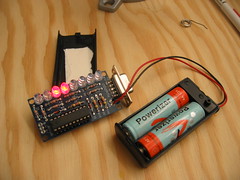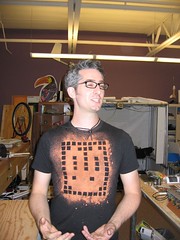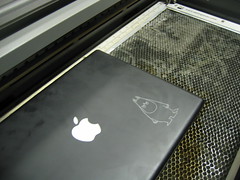My blog posts related to IT strategy, enterprise architecture, digital transformation,
and cloud have moved to a new home: ArchitectElevator.com.
This year I got to go to fooCamp! What is fooCamp? It is sort of like Burning Man for techno geeks. But just as Burning Man has gone pretty high tech fooCampers started
to have more fun by burning things. It's difficult to put the experience into words...
Highlights and Lowlights
Most embarrassing moment: At a session about stealth I asked Jay Adelson, Digg.com's CEO) which company he is with. Oops. On the bright side he told me that once he
arrived for a talk, entering as Larry Page was leaving the stage. Jay went on to introduce
himself and finished with "and you work for…" Doesn't misery love company!
 Made: fooCamp is about making stuff. I did not make anything particularly extraordinary
but managed to solder together a miniPov kit, consisting essentially of an Atmel microcontroller and 8 bright LEDs. Afterwards
I realized that Thinkpads actually do not have serial ports (they do have, out of
all things, a parallel port). So I had to wait until I got home to actually download
the firmware. The source is in "C" so maybe I will do a bit C programming, I was actually
amazed at the easy availability of an open source compiler (based on GCC and the winAVR
programming tools. No external hardware is needed to burn this microcontroller. Tinkering
with hardware and microcontrollers was like a flashback to my teenage years and college
when I used to do a lot of hardware, mostly around TTL chips and a NEC microcontroller.
Made: fooCamp is about making stuff. I did not make anything particularly extraordinary
but managed to solder together a miniPov kit, consisting essentially of an Atmel microcontroller and 8 bright LEDs. Afterwards
I realized that Thinkpads actually do not have serial ports (they do have, out of
all things, a parallel port). So I had to wait until I got home to actually download
the firmware. The source is in "C" so maybe I will do a bit C programming, I was actually
amazed at the easy availability of an open source compiler (based on GCC and the winAVR
programming tools. No external hardware is needed to burn this microcontroller. Tinkering
with hardware and microcontrollers was like a flashback to my teenage years and college
when I used to do a lot of hardware, mostly around TTL chips and a NEC microcontroller.
Coolest Device: Naturally, people were showing off all sorts of cool stuff, including a flame thrower,
a (non Google) map projection installation, a cell phone that looks like a regular
rotary phone (without cable) and lots more. I think my favorite is still Mitch's TV B Gone. It is a tiny remote control that sends the "power off" code for all popular tv
models. Hold it for a minute towards any tv you encounter and it will turn off. Very
cool. Good that I don't have one – I am sure I would take it to the first sports bar
and get beaten up by jockstraps when I nuke the tv in the middle of some game.
Coolest People: This category is difficult as fooCamp was packed with cool people. I think the guys
from Graffiti Research Lab deserve a special mention for their projection projects, their effort to make public
spaces in NYC more usable by building chairs out of priority mail boxes, and decorating
buildings with LED throwies. You can now buy bulk kits to make making throwies more economical.
Funniest Moment: Crazybob and Geir staged a session titled "Java still matters". No one showed up.
Silliest Moment: Formed the idea to create a map that visualizes my trip to Hakone in Japan that
makes use of Shinkansen, regular trains, tram, funicular, ropeway, boat, and bus (the
paddleboats were not running in the fall season). Plotting mode of transportation
in color coding across time, elevation, and level of excitement I would use this map
to triumph over Ed Tufte's favorite map of Napoleon's Russia campaign.
Proudest Moment: Rode a Segway hands free.
Friday
 Friday evening started with introductions. It was one impressive list of 250 people,
including the other celebrity Mitch Kapor, Ray Ozzie, and Jeff Bezos. Google showed
a strong presence, but each of the attendees was invited for work they did outside
or before they joined Google, which is good because foo is about individuals and not
about corporations. But it also worried me a little as I started to wonder whether
people will do cool enough things at Google (that they can talk about) that gets them
invited to foo.
Friday evening started with introductions. It was one impressive list of 250 people,
including the other celebrity Mitch Kapor, Ray Ozzie, and Jeff Bezos. Google showed
a strong presence, but each of the attendees was invited for work they did outside
or before they joined Google, which is good because foo is about individuals and not
about corporations. But it also worried me a little as I started to wonder whether
people will do cool enough things at Google (that they can talk about) that gets them
invited to foo.
I headed onto the Make area, run by the folks behind Makezine. These guys not only make cool stuff they also make great mojitos! Bre Pettis showed us some of his new projects. We could not stop laughing when we saw Pink Bunny and Magic Monkey Bob. After seeing the remix of the double decker bus video I won't be able to go to London
without thinking "downstairs, down, down, downstairs."
Friday evening I was able to score a Chumby, a small, cushy device with a reasonable CPU, a nice color LCD, WiFi, and Linux.
It runs Flash widgets like a Flickr photo viewer or stock quotes. Later, Bunnie and
his cohorts showed us how to turn a Teletubby into a Telechumby. Very cool.
Saturday
Saturday was filled with interesting sessions. The folks from Spark Fun Electronics revealed the innards of their cellular rotary
phone. They also built a very simple device consisting of a GPS antenna, a microcontroller
and an SD card. It samples your position every second or so and loads it onto the
SD card. Since it has no display and other gimmicks it can last a week or so on battery,
When you are done you insert the SD card into your PC and plot the data on Google
Earth or whatever. Great for vacations, especially in countries where it is difficult
to read street signs and remember where you went.
Geo Hacking
One hot topic was anything related to geotagging, mach-ups on top of maps or Earth
etc. In Japan 2D bar-codes are now the hit. You can take a picture with your cell
phone camera, which translates it into a URL. It is mostly used for advertising. Since
the URLs are mapped directly to the bar code no server round trip is required for
decoding. I believe a similar system is used by Emery-Go-Around to check the expected
arrival time of the next bus. However, that one requires a server roundtrip.
Another question that came up is that of a geopedia, i.e. a place where a large community
charts out the planet and gives information about buildings and locations. This would
be a big step towards the "tell me what this is" device that one could carry around
and point at buildings or points of interest.
Domain Specific Languages
Martin held a session on DSLs, asking people for their experiences. One interesting project
that was mentioned uses the C# Linq project to work against data sources such as Amazon. I am sure Martin is going to
post a nice summary of his session notes.
Out of Control
I hosted a session titled "out of control" (sexy titles always help improve attendance)
to discuss management and visualization of large Web sites. It was quite well attended
and it was great to get input from folks who run mlb.com, livejournal.com, puzzlepirates
etc. The session was adequately followed by "F*cking big Websites". I felt that too
many sessions had great discussions but little tangible take-away so I decided to
take notes during my session. I posted them on the fooCamp wiki.
Visualizations
After dinner I attended a great session around visualization. The session was split
into two parts. The first part dealt largely with maps addressing the problem that
a consistent level of detail is not useful if you are traveling 50 miles on the freeway
followed by having to navigate a maze of local streets. Some of the works out of Berkeley solve this problem through iterative optimization, creating a map that is much closer
to what a person would sketch up.
The second part used visualization techniques to track changes on Wikipedia topics.
The same code can be used against source code repositories. It is available on IBM
Alphaworks under "HistoryFlow" (great work by fviegas at media.mit.edu).
Laptop Tattoo
 The guys from the Graffiti Research Project brought a $15k laser engraver that quickly
turned a bunch of laptops into works of art. Our very own Chris deserves big kudos
for working past midnight to fulfill various fooCampers' wishes for unique designs.
Rumor has it one person ended up with Hello Kitty angel on the laptop. Definitely
unique.
The guys from the Graffiti Research Project brought a $15k laser engraver that quickly
turned a bunch of laptops into works of art. Our very own Chris deserves big kudos
for working past midnight to fulfill various fooCampers' wishes for unique designs.
Rumor has it one person ended up with Hello Kitty angel on the laptop. Definitely
unique.
Sunday
Chumby Hacks
We learned how to connect a serial port to a chumby to get a linux shell. The main
board has rx and tx pins and ground is easy to find. Main caveat: the rx amd tx pins
run directly into the microcontroller, which operates on 3.3 volts. Any attempt to
connect these wires into a "real" RS232 (with +/- 9 volts) will quickly transport
your chumby into the eternal chumbing grounds. Otherwise, set your serial port to
115kbs, 8N1 and no flow control. You can start an sshd daemon from the shell or mount
a USB still with content.
Technology Underground
Ever wondered how to make a potato cannon or pumpkin cannon? How about a flame throwing
robot? Just in time for burning man... A rail gun could be a lot of fun as well.
Global Geek Culture
Danny O'Brien gave one of the most entertaining talks about cultural differences.
The surprising cultural differences between the UK and the US motivated him to dig
up some research by Geert HofStede, who defined five cultural dimensions. Very interesting.
I am sure I missed a lot of interesting sessions. For example, I only caught the last
minutes of Pipes and Filters on the Web. I need to check out Dabble DB. Is there anything bad about fooCamp? Not really, the worst part is having to come
home to the daily grind…
 Hi, I am Gregor Hohpe, co-author of the book Enterprise Integration Patterns. I like to work on and write about asynchronous messaging systems, service-oriented architectures, and all sorts of
enterprise computing and architecture topics. I am also an Enterprise Strategist at
AWS.
Hi, I am Gregor Hohpe, co-author of the book Enterprise Integration Patterns. I like to work on and write about asynchronous messaging systems, service-oriented architectures, and all sorts of
enterprise computing and architecture topics. I am also an Enterprise Strategist at
AWS.





 Gregor is an Enterprise Strategist with Amazon Web Services (AWS). He is a frequent
speaker on asynchronous messaging, IT strategy, and cloud. He (co-)authored several
books on architecture and architects.
Gregor is an Enterprise Strategist with Amazon Web Services (AWS). He is a frequent
speaker on asynchronous messaging, IT strategy, and cloud. He (co-)authored several
books on architecture and architects.